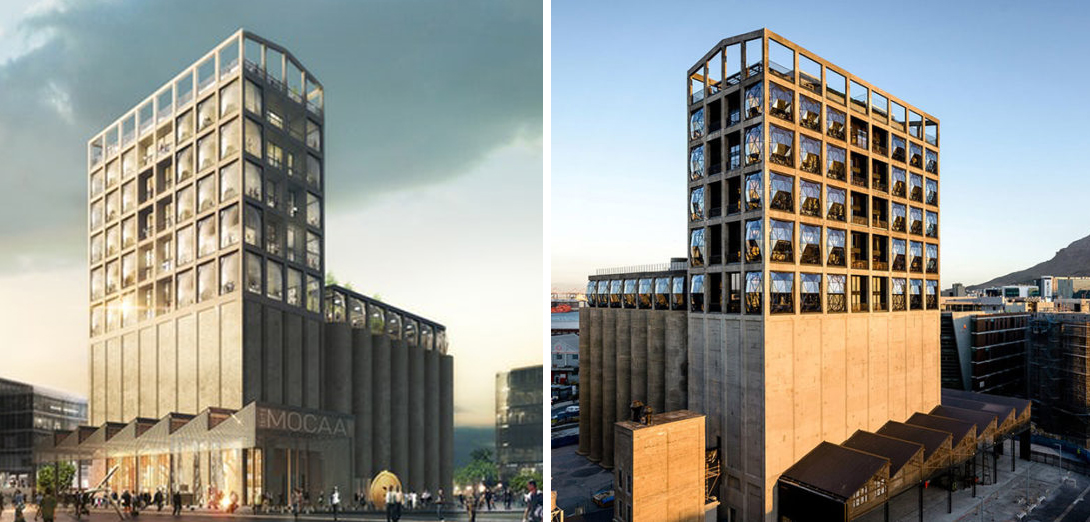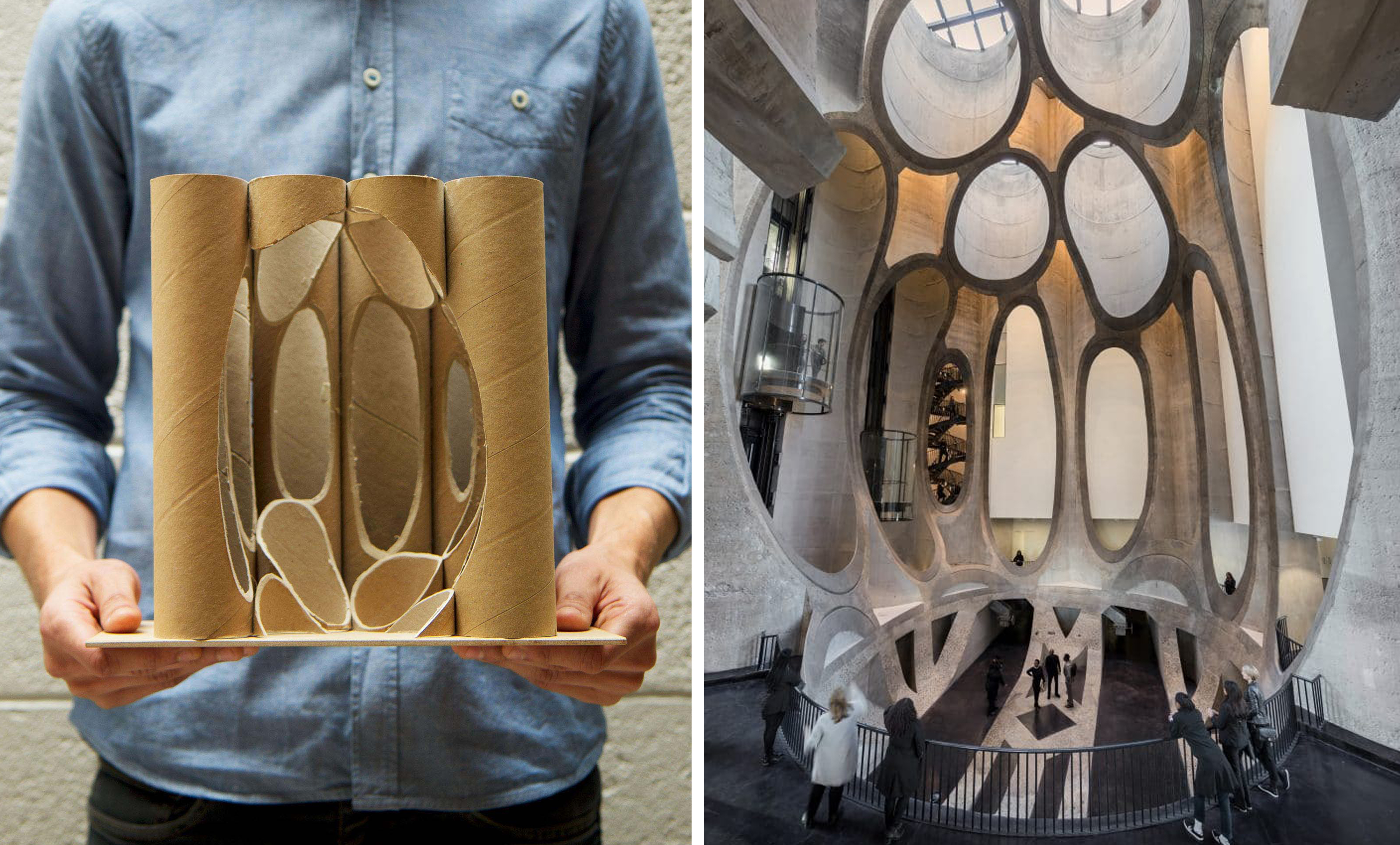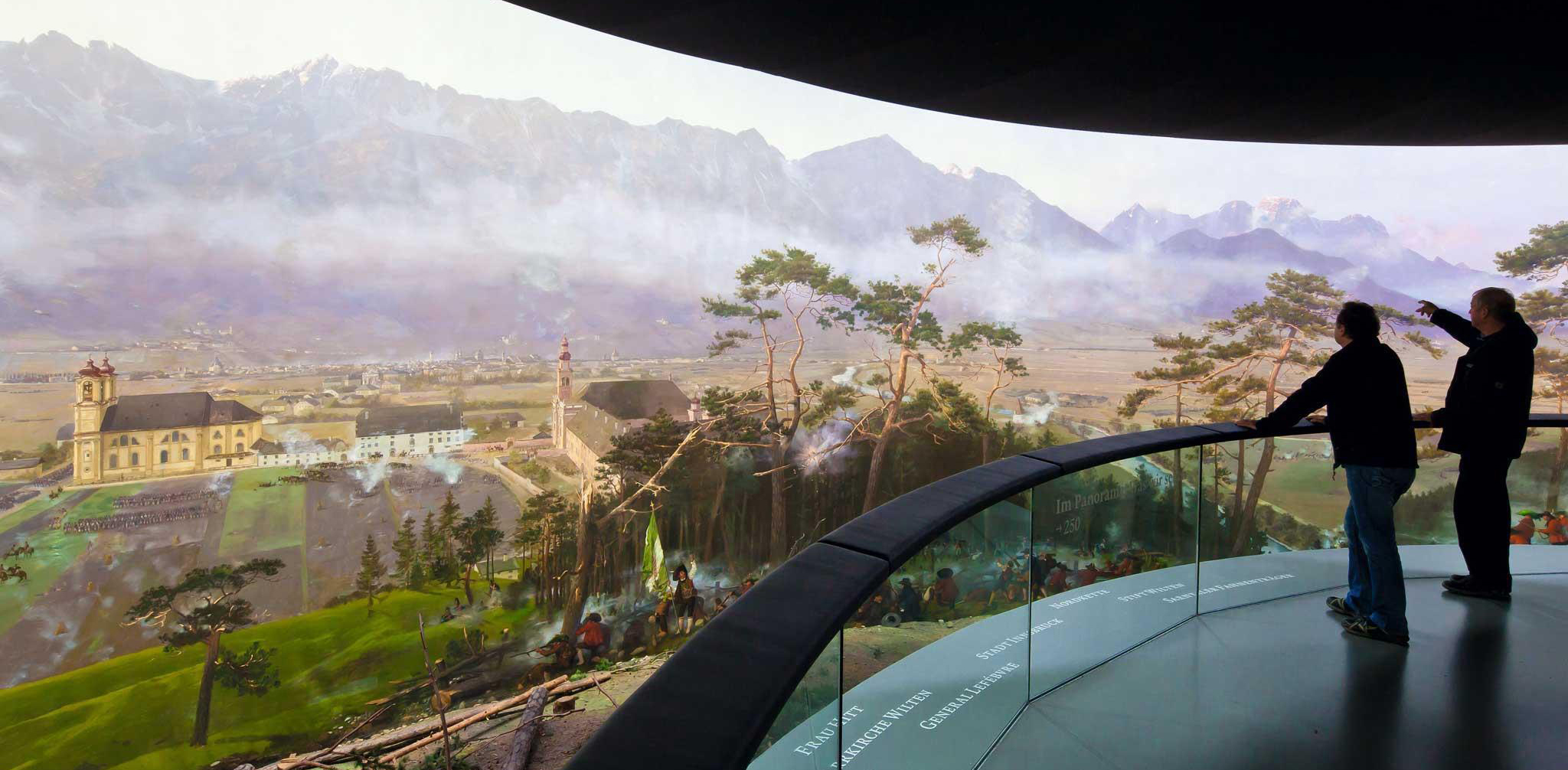Architects: Showcase your projects and find the perfect materials for your next project through Architizer. Manufacturers: To connect with the world’s largest architecture firms, sign up now.
How does one transform a collection of concrete tubes into a site for experiencing contemporary culture?
That was the question posed by British designer and artist Thomas Heatherwick of Heatherwick Studio, whose imaginative designs can be found everywhere from Manchester to Shanghai. Heatherwick is used to creating striking sculptures on a grand scale, but one of his most recent projects is larger than any before.
The designer and his team envisioned a glittering hotel atop an old silo in South Africa’s mother city, Cape Town, encasing luxury rooms with billowing panes of faceted glass. Beneath this, the concrete cylinders of the silo were carved out to create a huge new museum of contemporary art — the incredible, A+Award-winning Zeitz MOCAA.
For this monumental project, Heatherwick Studio’s challenge was twofold: Protect and celebrate the heritage of the city’s industrial past while simultaneously creating something wholly new within the inherited structure.

Rendered section of Heatherwick’s silo-to-museum transformation

Left: Rendering of the exterior view of the museum and hotel; right: The completed project
“Our thoughts wrestled with the extraordinary physical facts of the building,” Heatherwick explained at Design Indaba 2014, where he first unveiled his firm’s plans for the new V&A Museum in Cape Town’s historic waterfront district.
“There is no large open space within the densely packed tubes and it is not possible to experience these volumes from inside,” he continued. “Rather than strip out the evidence of the building’s industrial heritage, we wanted to find a way to enjoy and celebrate it. We could either fight a building made of concrete tubes or enjoy its tube-iness.”
In terms of technical archi-speak, “tube-iness” isn’t the most shining example, but Heatherwick’s point is clear enough. By carving away at the lower reaches of the silos and allowing light to stream down from above, a cave-like condition will be created. The remaining concrete tubes appear suspended above the void, their vertical elements flowing like stalactites to the gallery floor.

Interior rendering of the V&A Museum in Cape Town. Image via Fast Company

Left: working model of the museum interior; right: the completed atrium
In addition to the atmospheric qualities, the manipulation of the silo’s cylinders also provides practical benefits: An uninterrupted space is created in which people can gather and large artworks can be displayed, akin to the atria of conventional galleries (think of the central void of the Guggenheim in New York, or the Turbine Hall in London’s Tate Modern).
Silo conversion provides architects with tremendous spatial and material challenges, and Heatherwick’s solution appears admirable. How have other designers responded to the “tube-iness” test? Here are a few more examples of silo transformations.

Mill Junction, Johannesburg, South Africa
Just a few hundred miles northeast of Heatherwick’s museum, silos have been adapted in a very different manner. Matt Shaw reported for Architizer on Johannesburg’s Mill Junction student dormitories, which combine two industrial typologies — shipping containers of every conceivable color stacked atop 11-story grain silos. The transient nature of the crates contrasts with the stable forms of the cylinders beneath, creating one outlandish residential high-rise.

Gemini Residence, Copenhagen, Denmark
MVRDV proved that silo conversions don’t always have to be as rugged as Mill Junction. Its Gemini Residence features glossy, high-end apartments radiating from a pair of concrete silos that act as twin cores. The silos contain staircases, elevators and common spaces such as terraces, while the apartments provide a glittering outer skin — complete with the lengthiest wrap-around balconies imaginable.

Climbing Center, Amsterdam, Netherlands
In 2011, the city of Amsterdam held a competition for the best re-interpretation of three abandoned sewage treatment silos, prominent landmarks in the city’s Zeeburg District. One of the most compelling projects was submitted by Amsterdam-based firm NL Architects, which proposed to transform two of the silos into an undulating pair of climbing towers. In addition to climbing areas both inside and outside the silos, the design included multipurpose areas, offices, restaurants, and other commercial spaces.

Skydiving Center, Warsaw, Poland
If the thought of climbing the outside of these towering concrete structures appeals to you, try this one on for size: last year, MOKO Architects proposed the conversion of an abandoned cement silo into an indoor skydiving center. A scuba diving training well is also incorporated into the plan, taking advantage of the huge ten-story void within the concrete shell. MOKO also took a leaf out of the Mill Junction book of upcycling—they proposed attaching shipping containers to provide further space for cafes, an exhibition space, changing rooms and a hostel.
329 prepared dc-motors, cotton balls, toluene tank, Dottikon, Switzerland
In less capable hands, this project could have been a science experiment gone very, very wrong. But in the hands of Swiss artist Zimoun, simple objects transform an empty chemical tank into a mesmerizing soundscape. This immense, permanent installation is comprised of cotton balls attached to evenly distributed DC motors that endlessly oscillate inside the tank to produce an echoing drone akin to white noise. As with most contemporary art, the result engenders incredibly polarized views: some find the noise meditative, others find it maddening. Watch the video above and decide for yourself …

© Lighting Design Collective, Lighting Design Collective
Silo 468, Helsinki, Finland
Another sensory art installation, this disused oil silo in Helsinki was transformed by Lighting Design Collective as part of the city’s World Design Capital 2012 celebrations. Thousands of white and red LED lights were fitted behind a series of perforations in the silo walls, and the illumination pattern is based on a system that responds to factors such as wind speed, direction, temperature and weather conditions. Sunset is marked by fluctuations in lighting levels, turning the silo into a beacon that is visible from three kilometers away. This constantly changing “mural of light” gives each visitor a distinctive experience and creates a space in direct contrast to the structure’s industrial past.
Find all your architectural inspiration through Architizer: Click here to sign up now. Are you a manufacturer looking to connect with architects? Click here.




